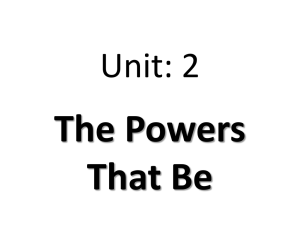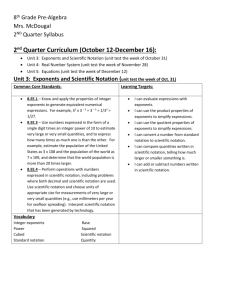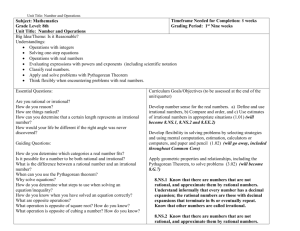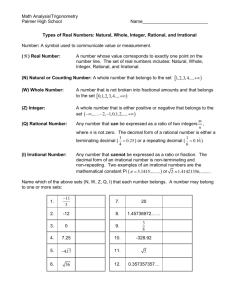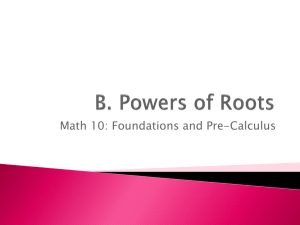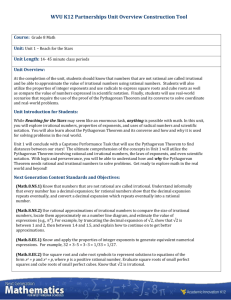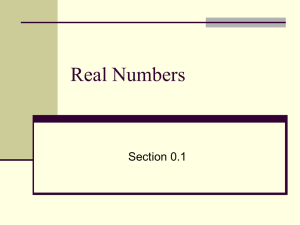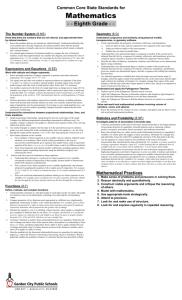Unit 1 - Currituck County Schools
advertisement
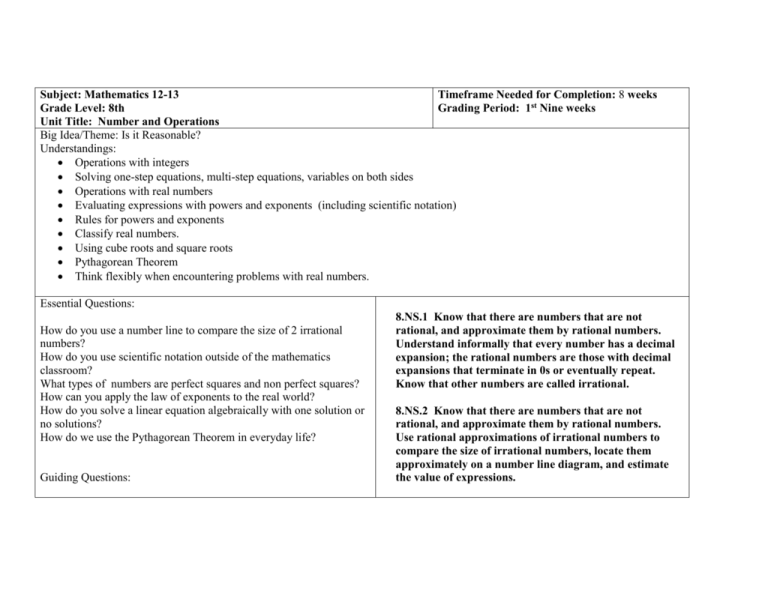
Timeframe Needed for Completion: 8 weeks Subject: Mathematics 12-13 Grade Level: 8th Grading Period: 1st Nine weeks Unit Title: Number and Operations Big Idea/Theme: Is it Reasonable? Understandings: Operations with integers Solving one-step equations, multi-step equations, variables on both sides Operations with real numbers Evaluating expressions with powers and exponents (including scientific notation) Rules for powers and exponents Classify real numbers. Using cube roots and square roots Pythagorean Theorem Think flexibly when encountering problems with real numbers. Essential Questions: How do you use a number line to compare the size of 2 irrational numbers? How do you use scientific notation outside of the mathematics classroom? What types of numbers are perfect squares and non perfect squares? How can you apply the law of exponents to the real world? How do you solve a linear equation algebraically with one solution or no solutions? How do we use the Pythagorean Theorem in everyday life? Guiding Questions: 8.NS.1 Know that there are numbers that are not rational, and approximate them by rational numbers. Understand informally that every number has a decimal expansion; the rational numbers are those with decimal expansions that terminate in 0s or eventually repeat. Know that other numbers are called irrational. 8.NS.2 Know that there are numbers that are not rational, and approximate them by rational numbers. Use rational approximations of irrational numbers to compare the size of irrational numbers, locate them approximately on a number line diagram, and estimate the value of expressions. How do you determine which categories a real number fits? Is it possible for a number to be both rational and irrational? What is the difference between a rational number and an irrational number? Why solve equations? How do you determine what steps to use when solving an equation/inequality? How do you know when you have solved an equation correctly? What are opposite operations? What operation is opposite of square root? How do you know? What operation is opposite of cubing a number? How do you know? 8.EE.1 Work with radicals and integer exponents. Know and apply the properties of integer exponents to generate equivalent numerical expressions. (from Algebra 1) 8.EE.2 Work with radicals and integer exponents. Use square root and cube root symbols to represent solutions to the equations of the form x2 = p and x3 = p, where p is a positive rational number. Evaluate square roots of small perfect squares and cube roots of small perfect cubes. Know that √2 is irrational. 8.EE.3 Work with radicals and integer exponents. Use numbers expressed in the form of a single digit times an integer power of 10 to estimate very large or very small quantities, and to express how many times as much one is than the other. (moved from 6th grade) 8.EE.4 Work with radicals and integer exponents. Perform operations with numbers expressed in scientific notation, including problems where both decimal and scientific notation are used. Use scientific notation and choose units of appropriate size for measurements of very large or very small quantities. Interpret scientific notation that has been generated by technology. (from Algebra 1) 8.EE.7 Give examples of linear equations in one variable with one solution, infinitely many solutions or no solutions. Show which of these possibilities is the case by successively transforming the given equation into simpler forms, until an equivalent equation of the form x = a, a = a, or a = b results (where a and b are different numbers). Solve linear equations with rational number coefficient, including equations whose solutions require expanding expressions using the distributive property and collecting like terms. 8.G.6 Understand and apply the Pythagorean Theorem. Explain a proof of the Pythagorean Theorem and its converse. (NEW) 8.G.7 Understand and apply the Pythagorean Theorem. Apply the Pythagorean Theorem to determine unknown side lengths in right triangles in real-world and mathematical problems in two and three dimensions. 8.G.8 Understand and apply the Pythagorean Theorem. Apply the Pythagorean Theorem to find the distance between two points in a coordinate system. (from Algebra 1 Essential Skills/Vocabulary: Assessment Tasks: Vocabulary Class Discussions Learning Logs Cornell Notes Think-Pair-Share Assessment Tasks con’t: Rational number Irrational number Decimal Repeating decimal Non—terminating decimal Essential Skills Estimate radical numbers to the nearest integer and between two integers. Order real numbers. Classify real numbers into rational and irrational. Approximation Greater than Less than Radical Square root Base Exponent Integer Expression Monomial Coefficient Numerical expression Cube root Squared Cubed Solution Perfect square Perfect cube Exponent Inverse operation Index Rational Irrational Scientific Notation Magnitude Standard Form Estimate Expand Decimal notation Powers of 10 Equation Variable Infinite solution Linear No solution Inverse operation Distributive property Determine factors and multiples of sets of numbers Solve real-world word problems involving rational numbers Simplify radical expressions Determine when two radical expressions are equivalent Problem Solving Skills guess and test make a table/chart/ make a diagram/picture make an organized list work backwards work a simpler problem extraneous information Concept Maps Graphic Organizers/Venn Diagrams Graphic Organizers/Venn Diagrams Interactive Notebook Group work Projects Quick writes Foldables RAFTS Combine like terms Distributive property Combine like terms Coefficient Inverse operations Equations Rational numbers Pythagorean theorem Converse Proof Legs Hypotenuse Right angle Square root Radical Materials Suggestions: NCDPI Resources: http://www.ncpublicschools.org/curriculum/mathematics/middlegrades/grade08/ http://mathlearnnc.sharpschool.com/cms/One.aspx?portalId=4507283&pageId=5149151 National Library of Manipulatives http://nlvm.usu.edu/en/nav/vlibrary.html NCTM Illuminations http://illuminations.nctm.org/ Lesson Plan sites and Activities: http://www.lessonplanspage.com/Math.htm http://www.ilovemath.org Math Graphic Organizers http://www.enchantedlearning.com/graphicorganizers/math/ Problem Solving/Problem Websites http://library.thinkquest.org/25459/learning/problem/ http://www.geom.uiuc.edu/~lori/mathed/problems/problist.html http://www.rhlschool.com/math.htm http://nces.ed.gov/nationsreportcard/itmrlsx/search.aspx Currituck County Website-Common Core Resources http://www.currituck.k12.nc.us/Page/3021 AVID Library/Mathematics Write Path Books I and II


